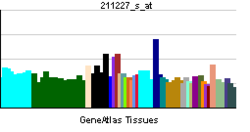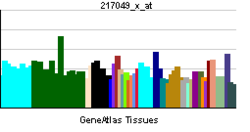- PCDH11X
-
Protocadherin 11 X-linked Identifiers Symbols PCDH11X; PCDH-X; PCDH11; PCDHX External IDs OMIM: 300246 MGI: 2442849 HomoloGene: 13194 GeneCards: PCDH11X Gene Gene Ontology Molecular function • calcium ion binding Cellular component • plasma membrane
• integral to plasma membraneBiological process • cell adhesion
• homophilic cell adhesionSources: Amigo / QuickGO RNA expression pattern 

More reference expression data Orthologs Species Human Mouse Entrez 27328 245578 Ensembl ENSG00000102290 ENSMUSG00000034755 UniProt Q9BZA7 Q2TJH5 RefSeq (mRNA) NM_001168360.1 NM_001081385.1 RefSeq (protein) NP_001161832.1 NP_001074854.1 Location (UCSC) Chr X:
91.03 – 91.88 MbChr X:
117.4 – 118.02 MbPubMed search [1] [2] Protocadherin 11 X-linked, also known as PCDH11X, is a protein which in humans is encoded by the PCDH11X gene.[1][2]
Contents
Function
This gene belongs to the protocadherin gene family, a subfamily of the cadherin superfamily. The encoded protein consists of an extracellular domain containing 7 cadherin repeats, a transmembrane domain and a cytoplasmic tail that differs from those of the classical cadherins. The gene is located in a major X/Y block of homology and its Y homolog (PCDHY), despite divergence leading to coding region changes, is the most closely related cadherin family member. The protein is thought to play a fundamental role in cell-cell recognition essential for the segmental development and function of the central nervous system. Transcripts arising from alternative splicing encode isoforms with variable cytoplasmic domains.[1]
Clinical significance
The PCDH11X gene has been linked as a risk factor in late onset Alzheimer's disease.[3]
References
- ^ a b "Entrez Gene: PCDH11X protocadherin 11 X-linked". http://www.ncbi.nlm.nih.gov/sites/entrez?Db=gene&Cmd=ShowDetailView&TermToSearch=27328.
- ^ Yoshida K, Sugano S (December 1999). "Identification of a novel protocadherin gene (PCDH11) on the human XY homology region in Xq21.3". Genomics 62 (3): 540–3. doi:10.1006/geno.1999.6042. PMID 10644456.
- ^ Carrasquillo MM, Zou F, Pankratz VS, Wilcox SL, Ma L, Walker LP, Younkin SG, Younkin CS, Younkin LH, Bisceglio GD, Ertekin-Taner N, Crook JE, Dickson DW, Petersen RC, Graff-Radford NR, Younkin SG (2009). "Genetic variation in PCDH11X is associated with susceptibility to late-onset Alzheimer's disease". Nature Genetics 41 (2): 192–8. doi:10.1038/ng.305. PMC 2873177. PMID 19136949. http://www.pubmedcentral.nih.gov/articlerender.fcgi?tool=pmcentrez&artid=2873177.
Further reading
- Yagi T, Takeichi M (2000). "Cadherin superfamily genes: functions, genomic organization, and neurologic diversity.". Genes Dev. 14 (10): 1169–80. PMID 10817752.
- Nollet F, Kools P, van Roy F (2000). "Phylogenetic analysis of the cadherin superfamily allows identification of six major subfamilies besides several solitary members.". J. Mol. Biol. 299 (3): 551–72. doi:10.1006/jmbi.2000.3777. PMID 10835267.
- Andersson B, Wentland MA, Ricafrente JY, et al. (1996). "A "double adaptor" method for improved shotgun library construction.". Anal. Biochem. 236 (1): 107–13. doi:10.1006/abio.1996.0138. PMID 8619474.
- Yu W, Andersson B, Worley KC, et al. (1997). "Large-scale concatenation cDNA sequencing.". Genome Res. 7 (4): 353–8. doi:10.1101/gr.7.4.353. PMC 139146. PMID 9110174. http://www.pubmedcentral.nih.gov/articlerender.fcgi?tool=pmcentrez&artid=139146.
- Yoshida K, Sugano S (2000). "Identification of a novel protocadherin gene (PCDH11) on the human XY homology region in Xq21.3.". Genomics 62 (3): 540–3. doi:10.1006/geno.1999.6042. PMID 10644456.
- Wu Q, Maniatis T (2000). "Large exons encoding multiple ectodomains are a characteristic feature of protocadherin genes.". Proc. Natl. Acad. Sci. U.S.A. 97 (7): 3124–9. doi:10.1073/pnas.060027397. PMC 16203. PMID 10716726. http://www.pubmedcentral.nih.gov/articlerender.fcgi?tool=pmcentrez&artid=16203.
- Nagase T, Kikuno R, Ishikawa KI, et al. (2000). "Prediction of the coding sequences of unidentified human genes. XVI. The complete sequences of 150 new cDNA clones from brain which code for large proteins in vitro.". DNA Res. 7 (1): 65–73. doi:10.1093/dnares/7.1.65. PMID 10718198.
- Blanco P, Sargent CA, Boucher CA, et al. (2000). "Conservation of PCDHX in mammals; expression of human X/Y genes predominantly in brain.". Mamm. Genome 11 (10): 906–14. doi:10.1007/s003350010177. PMID 11003707.
- Skaletsky H, Kuroda-Kawaguchi T, Minx PJ, et al. (2003). "The male-specific region of the human Y chromosome is a mosaic of discrete sequence classes.". Nature 423 (6942): 825–37. doi:10.1038/nature01722. PMID 12815422.
- Agate RJ, Choe M, Arnold AP (2004). "Sex differences in structure and expression of the sex chromosome genes CHD1Z and CHD1W in zebra finches.". Mol. Biol. Evol. 21 (2): 384–96. doi:10.1093/molbev/msh027. PMID 14660691.
- Blanco-Arias P, Sargent CA, Affara NA (2004). "Protocadherin X ( PCDHX) and Y ( PCDHY) genes; multiple mRNA isoforms encoding variant signal peptides and cytoplasmic domains.". Mamm. Genome 15 (1): 41–52. doi:10.1007/s00335-003-3028-7. PMID 14727141.
- Ross MT, Grafham DV, Coffey AJ, et al. (2005). "The DNA sequence of the human X chromosome.". Nature 434 (7031): 325–37. doi:10.1038/nature03440. PMC 2665286. PMID 15772651. http://www.pubmedcentral.nih.gov/articlerender.fcgi?tool=pmcentrez&artid=2665286.
- Wilson ND, Ross LJ, Crow TJ, Volpi EV (2006). "PCDH11 is X/Y homologous in Homo sapiens but not in Gorilla gorilla and Pan troglodytes.". Cytogenet. Genome Res. 114 (2): 137–9. doi:10.1159/000093329. PMID 16825765.
- Williams NA, Close JP, Giouzeli M, Crow TJ (2006). "Accelerated evolution of Protocadherin11X/Y: A candidate gene-pair for cerebral asymmetry and language.". American Journal of Medical Genetics Part B: Neuropsychiatric Genetics 141B (6): 623–633. doi:10.1002/ajmg.b.30357. PMID 16874762.

This protein-related article is a stub. You can help Wikipedia by expanding it.
